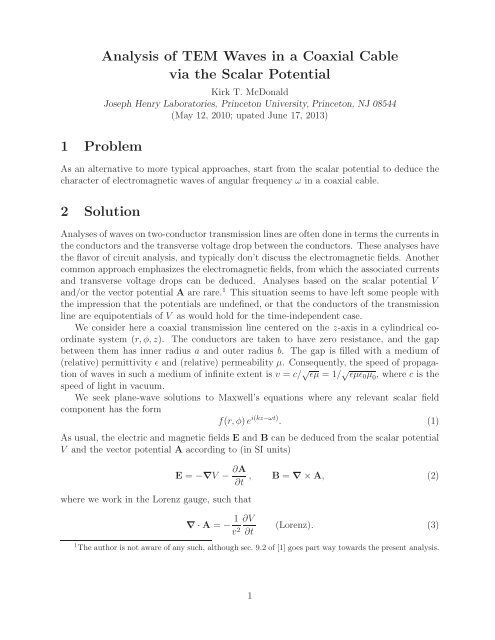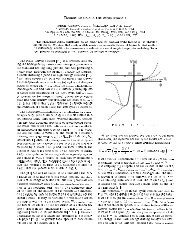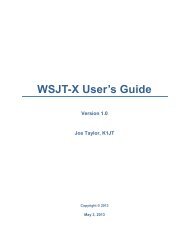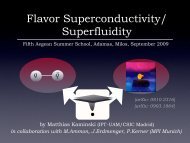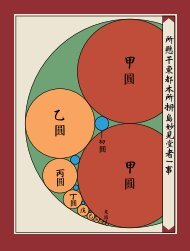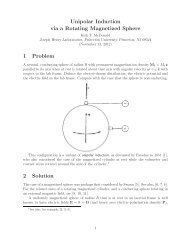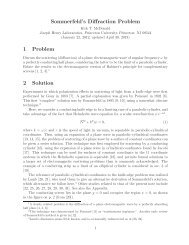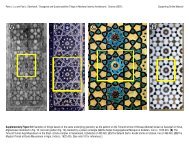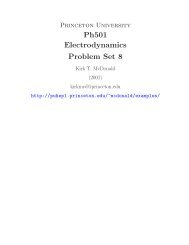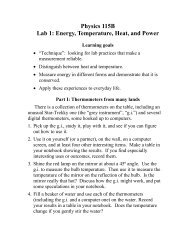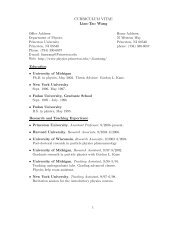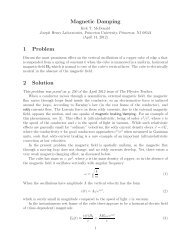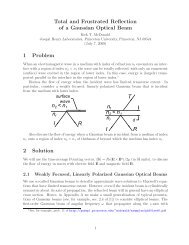Analysis of TEM Waves in a Coaxial Cable via the Scalar Potential 1 ...
Analysis of TEM Waves in a Coaxial Cable via the Scalar Potential 1 ...
Analysis of TEM Waves in a Coaxial Cable via the Scalar Potential 1 ...
You also want an ePaper? Increase the reach of your titles
YUMPU automatically turns print PDFs into web optimized ePapers that Google loves.
<strong>Analysis</strong> <strong>of</strong> <strong>TEM</strong> <strong>Waves</strong> <strong>in</strong> a <strong>Coaxial</strong> <strong>Cable</strong><br />
<strong>via</strong> <strong>the</strong> <strong>Scalar</strong> <strong>Potential</strong><br />
1 Problem<br />
Kirk T. McDonald<br />
Joseph Henry Laboratories, Pr<strong>in</strong>ceton University, Pr<strong>in</strong>ceton, NJ 08544<br />
(May 12, 2010; upated June 17, 2013)<br />
As an alternative to more typical approaches, start from <strong>the</strong> scalar potential to deduce <strong>the</strong><br />
character <strong>of</strong> electromagnetic waves <strong>of</strong> angular frequency ω <strong>in</strong> a coaxial cable.<br />
2 Solution<br />
Analyses <strong>of</strong> waves on two-conductor transmission l<strong>in</strong>es are <strong>of</strong>ten done <strong>in</strong> terms <strong>the</strong> currents <strong>in</strong><br />
<strong>the</strong> conductors and <strong>the</strong> transverse voltage drop between <strong>the</strong> conductors. These analyses have<br />
<strong>the</strong> flavor <strong>of</strong> circuit analysis, and typically don’t discuss <strong>the</strong> electromagnetic fields. Ano<strong>the</strong>r<br />
common approach emphasizes <strong>the</strong> electromagnetic fields, from which <strong>the</strong> associated currents<br />
and transverse voltage drops can be deduced. Analyses based on <strong>the</strong> scalar potential V<br />
and/or <strong>the</strong> vector potential A are rare. 1 This situation seems to have left some people with<br />
<strong>the</strong> impression that <strong>the</strong> potentials are undef<strong>in</strong>ed, or that <strong>the</strong> conductors <strong>of</strong> <strong>the</strong> transmission<br />
l<strong>in</strong>e are equipotentials <strong>of</strong> V as would hold for <strong>the</strong> time-<strong>in</strong>dependent case.<br />
We consider here a coaxial transmission l<strong>in</strong>e centered on <strong>the</strong> z-axis <strong>in</strong> a cyl<strong>in</strong>drical coord<strong>in</strong>ate<br />
system (r, φ, z). The conductors are taken to have zero resistance, and <strong>the</strong> gap<br />
between <strong>the</strong>m has <strong>in</strong>ner radius a and outer radius b. The gap is filled with a medium <strong>of</strong><br />
(relative) permittivity ɛ and (relative) permeability μ. Consequently, <strong>the</strong> speed <strong>of</strong> propagation<br />
<strong>of</strong> waves <strong>in</strong> such a medium <strong>of</strong> <strong>in</strong>f<strong>in</strong>ite extent is v = c/ √ ɛμ =1/ √ ɛμɛ 0 μ 0 ,wherec is <strong>the</strong><br />
speed <strong>of</strong> light <strong>in</strong> vacuum.<br />
We seek plane-wave solutions to Maxwell’s equations where any relevant scalar field<br />
component has <strong>the</strong> form<br />
f(r, φ) e i(kz−ωt) . (1)<br />
As usual, <strong>the</strong> electric and magnetic fields E and B can be deduced from <strong>the</strong> scalar potential<br />
V and <strong>the</strong> vector potential A accord<strong>in</strong>g to (<strong>in</strong> SI units)<br />
E = −∇V − ∂A ,<br />
∂t<br />
B = ∇ × A, (2)<br />
where we work <strong>in</strong> <strong>the</strong> Lorenz gauge, such that<br />
∇ · A = − 1 v 2 ∂V<br />
∂t<br />
(Lorenz). (3)<br />
1 The author is not aware <strong>of</strong> any such, although sec. 9.2 <strong>of</strong> [1] goes part way towards <strong>the</strong> present analysis.<br />
1
The wave equation for <strong>the</strong> scalar potential <strong>in</strong> <strong>the</strong> gap <strong>of</strong> <strong>the</strong> cable, away from ei<strong>the</strong>r<br />
sources or s<strong>in</strong>ks, is<br />
∇ 2 V = 1 v 2 ∂ 2 V<br />
∂t 2 . (4)<br />
Tak<strong>in</strong>g <strong>the</strong> scalar potential to have <strong>the</strong> form (1), <strong>the</strong> wave equation becomes<br />
1<br />
r<br />
∂<br />
∂r<br />
(<br />
r ∂f )<br />
+ 1 ∂ 2 f<br />
∂r r 2 ∂φ 2 − k2 f = − ω2 f<br />
v . (5)<br />
2<br />
We restrict <strong>the</strong> analysis to <strong>the</strong> simplest mode, which has no azimuthal dependence, and for<br />
which <strong>the</strong> wave number is related to <strong>the</strong> angular frequency by<br />
Then, f is a function <strong>of</strong> r only, and we have<br />
(<br />
d<br />
r df<br />
)<br />
=0,<br />
dr dr<br />
k = ω v . (6)<br />
df<br />
dr = K r , f = K ln r r 0<br />
. (7)<br />
To determ<strong>in</strong>e <strong>the</strong> constants K and r 0 we suppose that <strong>the</strong> scalar potential vanishes at r = b,<br />
and that <strong>the</strong> peak value <strong>of</strong> <strong>the</strong> potential at r = a is V 0 . Then,<br />
⎧<br />
0 (r>b),<br />
⎪⎨<br />
ln(r/b)<br />
f = V 0 = −V ln(a/b) 0 ln(r/b) (a
The electric and magnetic fields follow from (2) as<br />
E r = − ∂V<br />
∂r = ⎧⎪ ⎨<br />
⎪ ⎩<br />
0<br />
V 0<br />
r ln(b/a) ei(kz−ωt)<br />
(r>b),<br />
(a
A<br />
Appendix: Use <strong>of</strong> <strong>the</strong> Coulomb Gauge<br />
Instead <strong>of</strong> work<strong>in</strong>g <strong>in</strong> <strong>the</strong> Lorenz gauge (3), we could work <strong>in</strong> <strong>the</strong> Coulomb gauge, for which<br />
<strong>the</strong> gauge condition is<br />
∇ · A =0 (Coulomb). (21)<br />
In <strong>the</strong> Coulomb gauge <strong>the</strong> potentials are related to <strong>the</strong> “free” charge and current densities,<br />
ρ and J, by <strong>the</strong> differential equations (see, for example, Appendix A <strong>of</strong> [2])<br />
∇ 2 V = − ρ , (22)<br />
ɛɛ 0<br />
and<br />
∇ 2 A − 1 ∂ 2 A<br />
v 2 ∂t = −μμ 0J + 1 ∂∇V<br />
. (23)<br />
2<br />
v 2 ∂t<br />
The charge and current densities have time dependence e −iωt , and are periodic <strong>in</strong> z with<br />
wave number k = ω/v. We aga<strong>in</strong> consider only solutions with azimuthal symmetry, so <strong>the</strong><br />
scalar potential has <strong>the</strong> form<br />
V (r, z, t)=f(r)cos(kz)e −iωt . (24)<br />
Us<strong>in</strong>g this form <strong>in</strong> <strong>the</strong> gap between <strong>the</strong> conductors, where ρ = 0, eq. (22) becomes<br />
(<br />
d<br />
r df<br />
)<br />
− k 2 f =0. (25)<br />
dr dr<br />
This is a form <strong>of</strong> Bessel’s equation, whose solutions are <strong>the</strong> modified Bessel functions I 0 (kr)<br />
and K 0 (kr). As before, we take <strong>the</strong> boundary conditions to be V max (r = a) = V 0 and<br />
V (r = b) =0. Then,wehave<br />
f(r) =αI 0 (kr)+βK 0 (kr), (26)<br />
where<br />
V 0 = αI 0 (ka)+βK 0 (ka), and 0 = αI 0 (ka)+βK 0 (ka). (27)<br />
Solv<strong>in</strong>g this for α and β we f<strong>in</strong>d<br />
K 0 (kb)I 0 (kr) − I 0 (ka)K 0 (kr)<br />
f(r) =V 0<br />
I 0 (ka)K 0 (kb) − I 0 (kb)K 0 (ka) , (28)<br />
and so <strong>the</strong> scalar potential has <strong>the</strong> complicated form<br />
⎧<br />
0 (r>b),<br />
⎪⎨<br />
K<br />
V (r, z, t) = V 0 (kb)I 0 (kr)−I 0 (ka)K 0 (kr)<br />
0 I 0 (ka)K 0 (kb)−I 0 (kb)K 0 (ka) cos(kz)e−iωt (a
References<br />
[1] R.B. Adler, L.J. Chu and R.M. Fano, Electromagnetic Energy Transmission and Radiation<br />
(Wiley, New York, 1960).<br />
[2] See, for example, K.T. McDonald, The Helmholtz Decomposition and <strong>the</strong> Coulomb<br />
Gauge (April 17, 2008), http://puhep1.pr<strong>in</strong>ceton.edu/~mcdonald/examples/helmholtz.pdf<br />
5


